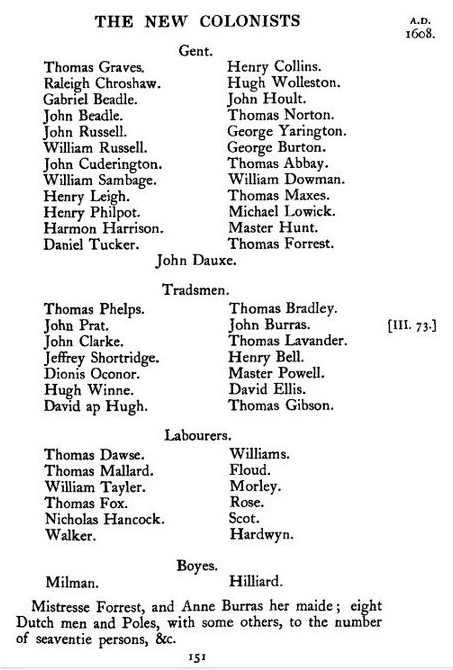Mother: Katherine Graves
Children:
Katherine Elizabeth Croshaw (1586-1636)
Elizabeth Mary (1610-1660)
Maj. Joseph Crowshaw (1612-1667)
Noah (1614-1665)
Benjamin (1616-)
Capt. Richard Crowshaw (1618-1667)
Raleigh was born in Croshaw, Lancashire, England in about 1570, being listed in some genealogies as the son of Joseph Croshaw and Katherine Graves. He married in England, but his wife's name is not known with certainty. They had at least one daughter named Katherine Elizabeth Croshaw, born in 1586 in Gravesend, Kent, England, who also came to the New World.
 |
 |
Croshaw was mentioned as being a member of the group with Captain John Smith in January 1609, who while attempting to trade for corn with the Indians at Opechancanough's village were almost overcome by surprise. This attack was thwarted in part by Raleigh Croshaw's quick reactions. Raleigh Croshaw then made a night trip back to Jamestown which helped to avoid further treachery. He appears to have been a very skilled Indian fighter.
At the time of the massacre in March 1622, he was on a trading cruise on the Potomac. According to Captain John Smith's General History, Croshaw challenged the chief Opchanacanough or any of his warriors to fight him naked (without armor), an offer that was not accepted. When Captain John Smith published his General History in 1624, one of the verses in Volume III of the book had been written by Croshaw--and in his writing, John Smith implies a high opinion of Croshaw's knowledge of Indians and their way of making war.
Raleigh Croshaw accompanied Claiborne on his explorations and, with just a few men, successfully defended a remote trading outpost up on the Potomac River in the 1622 attack. Captain Raleigh Croshaw was in the Potomac River trading in a small bark, commanded by Captain Spilman. There an Indian stole aboard and told them of the massacre (1622) and that Opchanacanough had been practicing with his King and Country to betray them, which they refused to do, but that the Indians of Werowocomoco had undertaken it. Captain Spilman went there, but the Indians after seeing that his men were so vigilant and well armed, suspected that they had been discovered, therefore, to delude him, they gave him such good deals in trade, that his vessel was soon nearly overloaded.
About 1623 a patent was issued to "Captain Raleigh Croshaw, Gentleman, of Kiccoughtan, "An Ancient Planter who hath remained in this country 15 years complete and performed many a worthy service to the Colony," for 500 acres by Old Point Comfort. "Planter" meant "settler". This was based on his transporting himself, his servant and his wife in addition to adventuring 25 pounds sterling in the Company.
By the following year he was a burgess for Elizabeth City. In March 1624 he was issued a commission to trade with the Indians for corn. On this voyage he purchased a "great canoe" for 10,000 blue beads. The Corporation of Elizabeth City states that "Captain Raleigh Croshaw planted by Patent 500 acres between Fox Hill and the Pamunkey River to establish Elizabeth City." Captain Raleigh Croshaw was last referred to on November 22, 1624, a date often given as his death date. On December 27, 1624, Capt. Francis West was instructed to take an inventory of his estate. The name of his wife does not appear in the estate settlement nor was she listed on the 1623 census, hence the belief that she was dead by that time. Several genealogies list his later children of being born to a second wife, daughter of an Indian chief, but that issue is beyond the scope of this article.
By 1637 the York County settlers had already begun to breach their own palisade and move into Indian land on the other side. The area between Queens Creek and Ware Creek was called the "Indian Fields." It was a series of vast communal fields the Indians used for planting corn. It was Joseph Croshaw and Richard Croshaw who were the first to move into the area. In 1637 and 1638, they each patented a few thousand acres about where the Camp Peary government center is located today. They controlled most of the land in that area for the next 20-25 years.